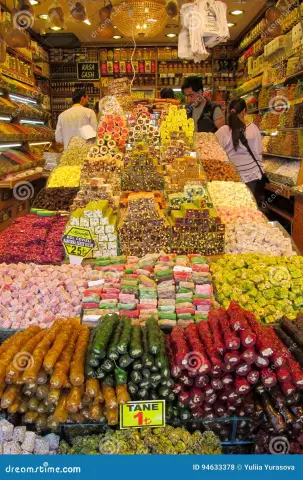- Author Rachel Wainwright [email protected].
- Public 2023-12-15 07:39.
- Last modified 2025-11-02 20:14.
Turkish Delight

According to legend Turkish delight was invented for the voluptuous sultan, who was a great lover of women. And, indeed, the benefit of Turkish delight is its ability to increase potency and saturate the body with energy for amorous pleasures.
Description
Turkish delight is a famous oriental sweet. Turkish delight contains molasses, sugar and starch, and various ingredients are added for a variety of flavors - berry or fruit juice, nuts, fresh berries, chocolate, candied fruits, vanilla, coconut, etc.
Turkish delight was invented at the end of the 18th century in Istanbul, and in many ways its recipe has remained unchanged to this day. Traditionally, the preparation of sweets takes two days, so it is problematic to cook Turkish delight at home, but if you have hard work and desire, it is possible. The secret to proper preparation is to thoroughly and constantly stir the sweet mass and observe a long cooling period.
Preparation and composition of Turkish delight
At the first stage, 400 ml of water, previously infused on rose petals, and 4 cups of sugar are mixed, 1 tablespoon of lemon juice is added. This mixture is put on high heat and brought to a boil for ten minutes. The finished syrup is removed from the heat and cooled. The second stage of preparation begins with whipping 3 glasses of water, 1 glass of starch and 1 teaspoon of tartar. The resulting mass is heated over a low heat, stirring constantly, so that no lumps form. After the mass has boiled, chilled syrup is poured into it in a thin stream, stirring continuously. At the third stage, the sweet workpiece is cooked at a temperature not exceeding 80 ° C for several hours, stirring constantly, until the mass thickens and becomes golden brown. After this, the pan is removed from the heat,and then the transformation of the sweet thick mass into a delicious oriental sweetness begins. Candied fruits, nuts, vanilla, grated chocolate and other components are added to the sweet base, depending on what taste the cook wants to get. Moreover, the amount of additional ingredients can take up a third of the volume of the entire mass.
In conclusion, the culinary specialist pours the still warm and liquid Turkish delight onto a sheet of parchment laid out on a baking sheet and oiled with vegetable oil. To distribute the mass evenly on the sheet, lightly shake and shake the baking sheet, cover the mass on top with plastic wrap and leave it to harden. After about 12 hours, Turkish delight is given the required shape using special molds or an ordinary sharp knife. Sprinkle the resulting delicacy on top with a mixture of powdered sugar and starch or coconut. Store the finished sweetness in a special container or wrapped in paper to avoid contact with air.
History
The history of the most exquisite and popular oriental sweets is known reliably, unlike many others, regarding the origin of which there are different opinions.
Turkish delight was invented by the court confectioner of the Turkish Sultan, Ali Haji Bekir, at the end of the 18th century. But about the circumstances preceding the invention, there are several opinions. According to one hypothesis, the great sultan was a great sweet tooth. Once he broke a tooth on hard candy and got so angry with the pastry chef that he came up with a new soft dessert literally overnight. Turkish delight in Arabic means “convenient pieces”.
According to another hypothesis, the Arab sultan was very fond of women and had a large harem. The habit of giving his women pleasure not only with the help of carnal pleasures, but also with preliminary delicious treats, forced him to demand from his confectioners the invention of new unusual sweets, more and more varied and complex. As a result, Haji Bekir came up with a universal Turkish delight, which included sugar, rose water and starch, and diversified its taste by adding various ingredients. Regardless of what is true, the sultan and his chef made all sweet tooth happy for hundreds of years to come, because this viscous and delicate delicacy is popular in many countries of the world to this day.
It is known that the descendants of Haji Bekir became rich and famous owners of a sweets shop in Istanbul, and in the 19th century they presented Turkish delight at the Brussels exhibition. The sweetness received a gold medal and was widespread throughout Europe. In Europe, Turkish delight began to be called "Turkish Delight", or "Turkish delight". The British especially loved the sweetness, where they used it for a five-hour tea party. Currently, there are a huge number of types of Turkish delight, of a wide variety of forms - these are nut, fruit, two-layer, cubic, children's, sliced, fig, white, honey and many other types.
Calorie content of Turkish delight

Like many sweets, the calorie content of Turkish delight is quite high and amounts to about 350 kcal per 100 g of product. Therefore, it is better for them not to abuse and not eat this sweetness more than 50 grams per day. And if you want to get rid of excess weight, then it would be best to give it up for a while.
Since the Turkish delight contains sugar, its excessive use causes "disruptions" of fat metabolism, which is often the reason for an increase in body weight and fat formation.
The benefits of Turkish delight
The high calorie content of Turkish delight still does not give a reason to class it as a harmful product. Indeed, this oriental delicacy contains glucose, which, without a doubt, is useful for the human body. Thanks to the effect of glucose, cardiac activity and the work of the brain are improved, the production of endorphins, hormones that raise mood and the level of efficiency, increases. In addition, the glucose, which is part of Turkish delight, has a beneficial effect on the condition of the hair and improves intestinal peristalsis.
Some will find it very strange, but Turkish delight is also beneficial in enhancing immunity. It turns out that glucose in combination with starch forms a component that helps the human body fight colds and viral diseases.
The benefits of Turkish delight largely depend on the additives included in the recipe. So, for example, slices of orange or lemon help cure a cold, honey improves blood quality and normalizes digestion, berries and fruit juices saturate the body with useful vitamins and minerals.
Contraindications
Due to the high calorie content of Turkish delight and the high sugar content, sweetness in the body turns into fat and is deposited under the membranes of internal organs and skin. Therefore, excessive consumption of sweets leads to hypertension, diabetes and obesity.
Among other things, an oriental delicacy disrupts the secretion of enzymes in the stomach, pancreas and intestines, and also spoils tooth enamel. Therefore, in the presence of chronic diseases and a sedentary lifestyle, Turkish delight is better not to use at all.
Found a mistake in the text? Select it and press Ctrl + Enter.






